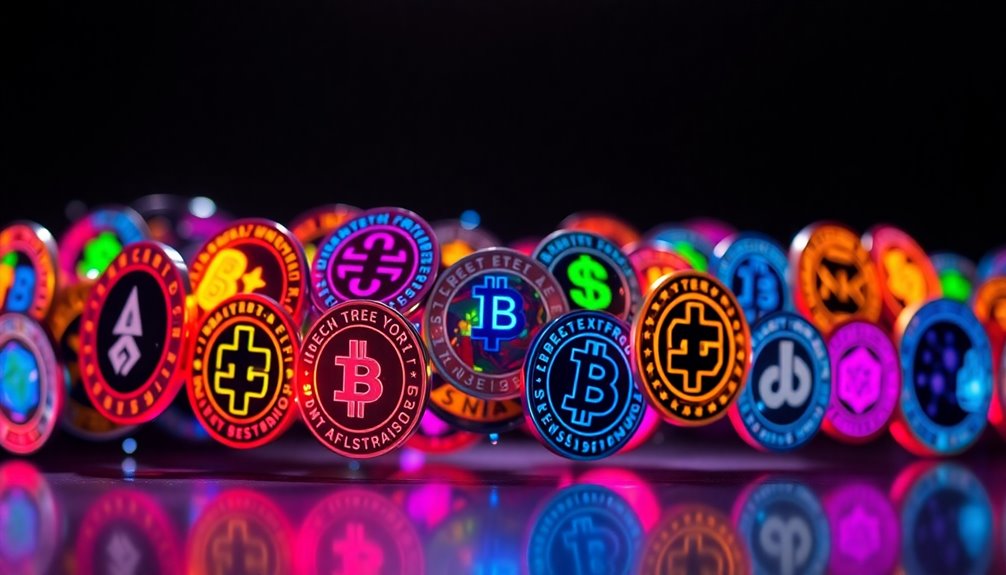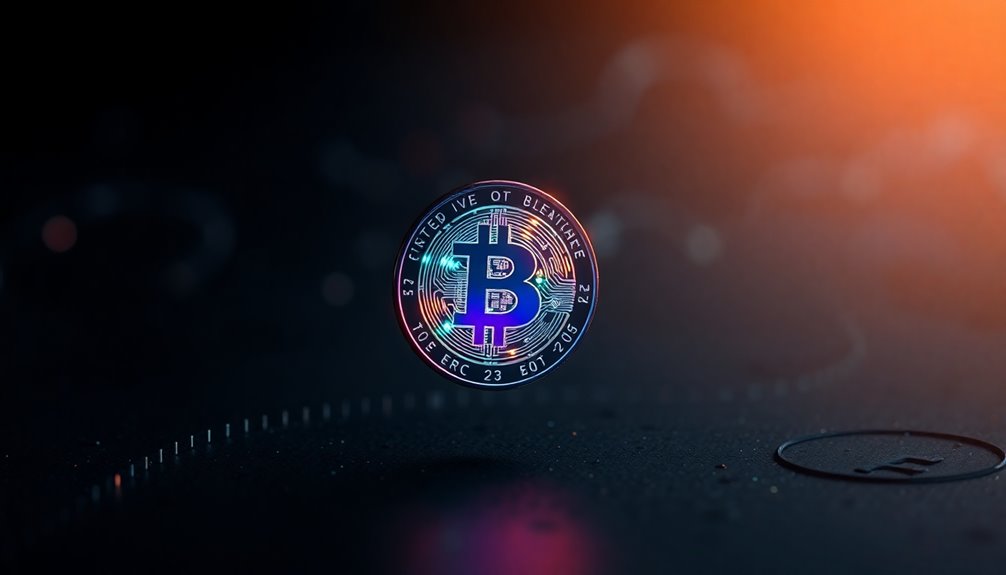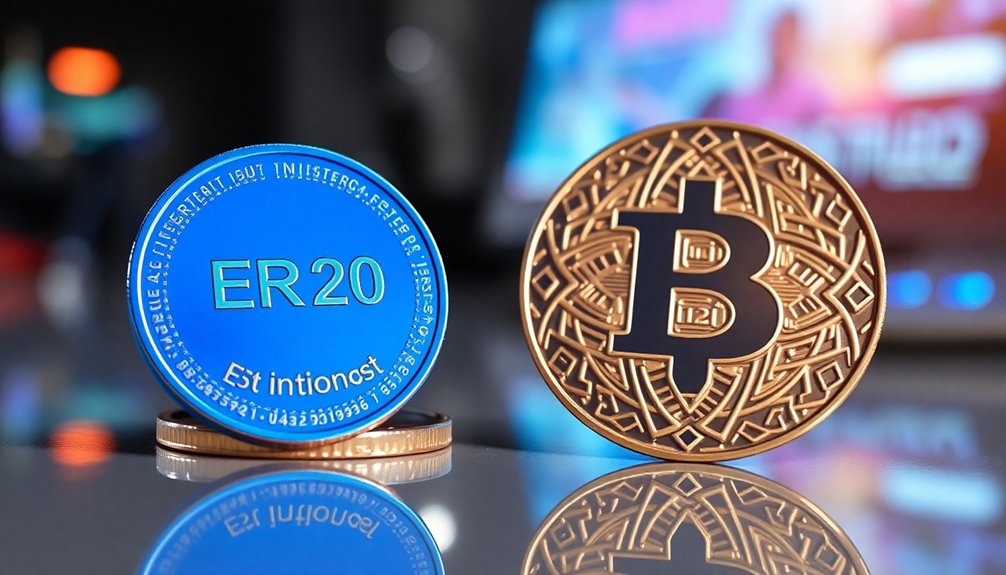ERC-20 is a vital standard for creating fungible tokens on the Ethereum blockchain. Introduced in 2015, it defines essential functions like totalSupply and transfer, helping you manage token interactions seamlessly. With over 500,000 tokens created, ERC-20 enhances liquidity and fosters a thriving DeFi ecosystem. It allows for interoperability across wallets and exchanges, making transactions smoother. Notable examples include Tether and Chainlink, which you might have come across. If you want to dive deeper into how ERC-20 impacts the crypto world, you'll discover even more intriguing details that can boost your understanding.
Key Takeaways
- ERC-20 is a standard for creating fungible tokens on the Ethereum blockchain, enabling interoperability among various tokens and platforms.
- Introduced in 2015 by Fabian Vogelsteller, it defines essential functions like transfer, balanceOf, and totalSupply for token management.
- Over 500,000 ERC-20 tokens have been created, including popular examples like Tether (USDT) and Chainlink (LINK).
- The standard enhances liquidity and facilitates seamless trading, fostering a vibrant decentralized finance (DeFi) ecosystem.
- Security vulnerabilities and high gas fees are notable challenges, necessitating thorough auditing and caution in token transactions.
Token Standard Fundamentals

When you explore the world of cryptocurrencies, you'll quickly notice that ERC-20 stands out as a crucial standard for fungible tokens on the Ethereum blockchain. Introduced in 2015, this token standard facilitates interoperability among various tokens and decentralized applications (dApps).
It defines essential functions like totalSupply, balanceOf, transfer, approve, and transferFrom, which streamline token management and transactions. Since its formalization in 2017, over 500,000 ERC-20 tokens have emerged, solidifying its dominance within the Ethereum ecosystem.
The fungibility of these tokens allows for seamless trading and integration across wallets and exchanges, enhancing liquidity. By using smart contracts, ERC-20 tokens empower decentralized finance (DeFi) projects, creating a standardized framework for asset interaction and management.
ERC-20 Token Overview

ERC-20 tokens represent a significant advancement in the realm of digital currencies, providing a standardized framework for creating and managing fungible tokens on the Ethereum blockchain.
Introduced in 2015 by developer Fabian Vogelsteller, the ERC-20 standard specifies essential functions like transfer, balanceOf, and approve, ensuring interoperability across wallets and exchanges.
With over 500,000 ERC-20 tokens created, popular examples include Tether (USDT), Chainlink (LINK), and Basic Attention Token (BAT).
This standard fosters a vibrant decentralized finance (DeFi) ecosystem, enabling seamless token transactions and interactions among various tokens.
Token Creation Process Explained

Creating an ERC-20 token involves a series of straightforward steps that define its unique attributes. First, you'll use the Solidity programming language to outline key parameters like Initial Token Supply and Decimals.
To enhance security, it's common to utilize frameworks like OpenZeppelin for smart contract development, reducing potential vulnerabilities.
Once your token is coded, you'll deploy it on the Ethereum network, which requires paying gas fees based on current network congestion. Tools such as Remix and Truffle make the development and testing process seamless.
Finally, ensure your ERC-20 token implements mandatory functions like 'transfer', 'approve', and 'balanceOf' to maintain compliance with the ERC-20 standard and ensure interoperability within the Ethereum ecosystem.
Pros and Cons Summary

While exploring the world of cryptocurrencies, it's crucial to weigh the pros and cons of ERC-20 tokens.
On the positive side, the ERC-20 standard enhances interoperability, allowing seamless trading and integration across Ethereum-based applications and wallets, fostering a vibrant decentralized finance (DeFi) ecosystem. Additionally, this standardized framework simplifies development and auditing for developers.
However, there are drawbacks. Security vulnerabilities in smart contracts can lead to token theft, necessitating thorough auditing. Network congestion on the Ethereum blockchain may result in high gas fees during peak times, impacting transaction efficiency.
Furthermore, regulatory uncertainty surrounding cryptocurrencies poses challenges, as it may affect trust and adoption of ERC-20 tokens among users. Balancing these factors is essential for informed decision-making.
ERC-20 vs. ERC-721 Differences

When comparing ERC-20 and ERC-721 tokens, it's essential to understand their fundamental differences.
ERC-20 tokens are fungible tokens, meaning each one is interchangeable and identical. In contrast, ERC-721 tokens are non-fungible tokens, representing unique assets with distinct values, like digital art.
The ERC-20 standard includes standardized functions for efficient token transactions, while ERC-721 adds functions like 'ownerOf' and 'tokenURI' to track ownership and metadata.
ERC-20 tokens thrive in decentralized finance (DeFi) applications, whereas ERC-721 tokens find their place in NFT marketplaces, highlighting unique trading dynamics.
The total supply of ERC-20 tokens can be predetermined, while ERC-721 allows for varying quantities, emphasizing their individual nature.
Market Volatility Impacts Investments

Market volatility can significantly impact your investments in ERC-20 tokens, causing rapid price fluctuations that may catch you off guard. Daily changes of over 10% can occur due to shifts in trading volume and market sentiment, affecting investor confidence.
High volatility often deters long-term investments, as you might hesitate to commit funds to assets that can lose value quickly. With market capitalization of ERC-20 tokens sometimes exceeding $100 billion, the potential for large swings is evident.
Events like regulatory news and technological advancements can trigger sharp price movements, leading to instability. Additionally, around 75% of ERC-20 tokens may experience reduced liquidity during these volatile periods, complicating your ability to buy or sell without impacting prices.
Market Adoption Rates Increasing

As the cryptocurrency landscape evolves, the adoption rates of ERC-20 tokens continue to surge, reflecting a growing interest from investors and developers alike.
Over 500,000 ERC-20 tokens have been created, showcasing significant market adoption on the Ethereum blockchain. This rise is largely fueled by decentralized finance (DeFi) applications, where billions of dollars are locked in protocols that rely on these tokens for liquidity and governance.
Major exchanges and wallet providers now support ERC-20 tokens, making trading easier and further integrating them into the cryptocurrency ecosystem.
Additionally, the ERC-20 standard has paved the way for thousands of Initial Coin Offerings (ICOs), solidifying its role in fundraising and contributing to the substantial growth in market capitalization for these tokens.
Diversify Token Holdings Wisely

To successfully navigate the volatile world of cryptocurrencies, it's crucial to diversify your ERC-20 token holdings wisely.
With over 500,000 ERC-20 tokens available, you can spread your investments across stablecoins like USDT for stability and innovative utility tokens for growth potential.
Engaging in decentralized finance (DeFi) platforms allows you to enhance portfolio returns through yield farming and liquidity provision, leveraging multiple tokens for passive income.
By holding a mix of governance tokens from DeFi protocols, you can participate in decision-making, aligning your interests with the ecosystem's growth.
Keep an eye on market trends and project fundamentals to make informed decisions, enabling you to adjust your token holdings based on performance and emerging opportunities.
Frequently Asked Questions
What Does ERC-20 Mean?
ERC-20 refers to a standard for creating tokens on the Ethereum blockchain.
It defines essential functions that allow these tokens to interact seamlessly with other applications and tokens within the ecosystem. By following this standard, you can ensure your token is compatible with wallets and exchanges.
This interoperability fosters innovation in decentralized applications and finance, leading to the creation of thousands of tokens that enhance the Ethereum network's capabilities and user experience.
Is ERC-20 the Same as USDT?
No, ERC-20 isn't the same as USDT.
ERC-20 is a technical standard for creating fungible tokens on the Ethereum blockchain, while USDT is a specific token that follows this standard.
Essentially, USDT is one of many tokens built using the ERC-20 framework.
It serves as a stablecoin pegged to the US dollar, widely used in trading and decentralized finance, benefiting from the interoperability that ERC-20 provides.
Is ERC-20 the Same as Ethereum?
No, ERC-20 isn't the same as Ethereum.
ERC-20 is a standard for creating fungible tokens on the Ethereum blockchain, while Ethereum itself is the underlying platform that supports these tokens and smart contracts.
Think of Ethereum as the foundation, and ERC-20 tokens as the various applications built on top of that foundation.
They work together, but they serve different purposes in the blockchain ecosystem.
What Is an Example of an ERC-20 Wallet?
An example of an ERC-20 wallet you might consider is MetaMask. It's a popular choice, allowing you to manage your Ethereum and ERC-20 tokens easily.
You can also explore Trust Wallet, which offers a user-friendly interface for various cryptocurrencies.
If security's your priority, Ledger hardware wallets are great for keeping your tokens offline.
For a web-based option, MyEtherWallet lets you interact directly with your tokens while keeping your private keys secure.
Conclusion
In summary, ERC-20 tokens are a fundamental part of the Ethereum ecosystem, offering a standardized way to create and manage digital assets. While they come with their pros and cons, understanding their unique features and differences from other token standards like ERC-721 can help you make informed investment decisions. As market adoption grows, consider diversifying your token holdings wisely to mitigate risks and seize opportunities in this dynamic landscape.









